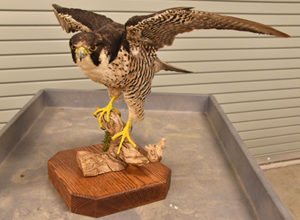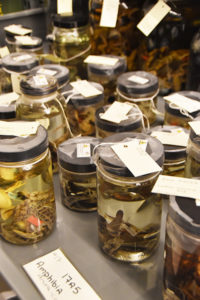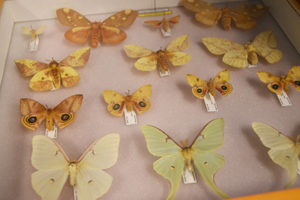Published May 28, 2019
Guest blog: Behind the museum’s biology collection
 If you’ve visited the Indiana State Museum, you might’ve noticed animals in several of our experiences and thought to yourself: Are those real?
If you’ve visited the Indiana State Museum, you might’ve noticed animals in several of our experiences and thought to yourself: Are those real?
The answer is yes – they are, and they come from the museum’s taxidermy collection. But, these animals come to us in a variety of unusual ways, according to Damon Lowe, senior curator of science and technology for the museum, who also curates the biology collection.
In this guest blog, learn how we acquire these animals, from the person behind the collection.
The Indiana State Museum’s taxidermy collection
By Damon Lowe, senior curator of science and technology
One of the most common questions I get asked at the museum is, “Where do you get all of your animals that you have on display?”
 That’s a pretty tricky question, because there is no single answer. Most of the specimens that our visitors see when they walk through the galleries, like the skunk in Natural Regions or the shrew in 19th State, were unfortunate accident victims that were found by concerned citizens and donated to us. Some specimens come from other methods of donation.
That’s a pretty tricky question, because there is no single answer. Most of the specimens that our visitors see when they walk through the galleries, like the skunk in Natural Regions or the shrew in 19th State, were unfortunate accident victims that were found by concerned citizens and donated to us. Some specimens come from other methods of donation.
While a lot of our specimens are casualties of vehicles, others come in from a less gruesome end. I work with a network of people throughout the state who know we are always looking for specimens, so they contact me when they find something and ask if I’m interested in it.
For example, this could be a wildlife rehabilitator who wasn’t able to save a rare bird and would like to see it used to help educate the public about the species. Or, it could be a phone call with a donor who wants us to come get a late relative’s trophy hunting collection of taxidermy animals.
 In these cases, we pack everything up and bring it back to the museum. There, we decide what is appropriate for our museum to keep and then try to find a home for everything else at another institution where it would be more appropriate. We have acquired moose, bears, wolves, deer, bobcats and a lion from calls like this, and helped a python find a better home.
In these cases, we pack everything up and bring it back to the museum. There, we decide what is appropriate for our museum to keep and then try to find a home for everything else at another institution where it would be more appropriate. We have acquired moose, bears, wolves, deer, bobcats and a lion from calls like this, and helped a python find a better home.
I also work with scientists at many universities across the state who collect specimens as part of their research. Once they are done studying these specimens, they often look for a place for them and we take the ones that fit within the scope of our collections. This includes things like frogs, turtles, fish, insects and small mammals.
Another way specimens come into our collection is through our relationship with DNR conservation officers. Since they are constantly out in the field encountering animals, conservation officers have the opportunity to come across some pretty interesting and sometimes rare specimens that are occasionally offered to the museum. We have obtained many hawks, songbirds, river otters and owls from our friends at DNR.
 No matter how we receive specimens, in all scenarios we have the proper scientific collecting permits issued by both the state and federal authorities to conduct our activities. People without these permits can’t just go out and pick up birds and many other animals for their own use.
No matter how we receive specimens, in all scenarios we have the proper scientific collecting permits issued by both the state and federal authorities to conduct our activities. People without these permits can’t just go out and pick up birds and many other animals for their own use.
If you find something, please check with a conservation officer before picking it up or you can get into serious trouble. However, you can always call someone at the museum or a historic site. We all have permits to pick things up – and it might just be the next jewel in our collection!









